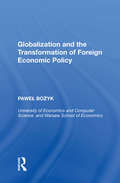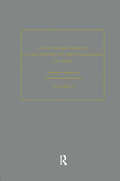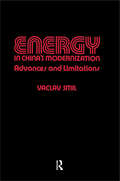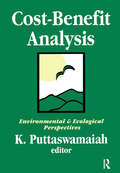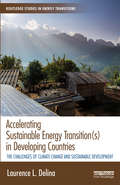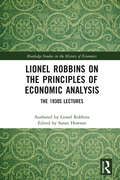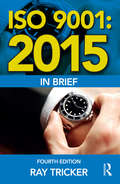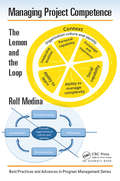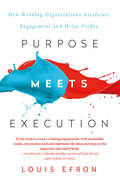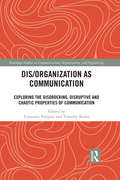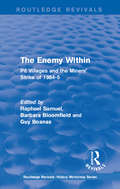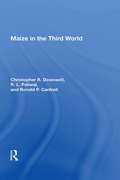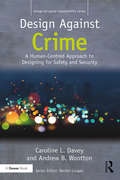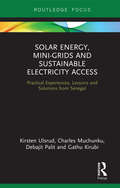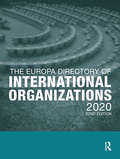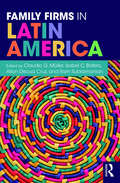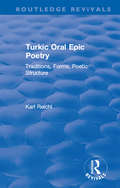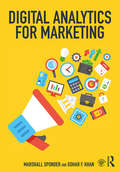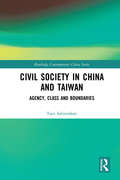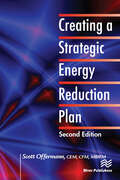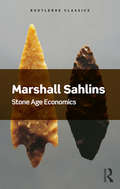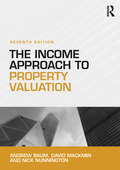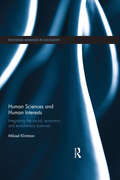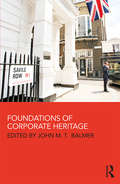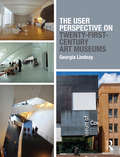- Table View
- List View
Globalization and the Transformation of Foreign Economic Policy
by Pawel BozykThe onslaught of globalization has brought with it sweeping changes to the foreign economic policy of the last 50 years. As the international political economy of nations and regions continues to be drawn and redrawn, this book traces the goals and instruments of foreign economic policy during this period, providing insight into the long-run trends and developing new theoretical generalizations. The book charts the journey from the point when foreign economic policy was solely concerned with foreign trade - pursued to promote the interests of individual countries - to the current globalization of the world economy that creates a uniform market in goods, services and factors of production that embrace all countries and regions.
The Economic Aspects of the History of the Civilization of Japan (Routledge Library Editions)
by Yosaburo TakekoshiOriginally published by Allen & Unwin in 1930 this 3-volume collection brings together writings on the economic aspects of Japan's history. Covering the period from the 1600s until the 1920s this work offers the reader, not only an economic history of the Japanese, but also a social and political history. By explaining the realities of daily life during the periods covered, this collection allows the economic aspects to be fully appreciated.
Energy in China's Modernization
by Vaclav SmilA selection of 50 Slovak folk tales assembled from the collections of folklorist Pavol Dobsinsky. The translator seeks to preserve the poetic qualities of the originals, and the book includes an introduction to the genres of the folktale and the specifics of Slovak tales.
Cost-benefit Analysis: With Reference to Environment and Ecology
by James H. Meisel K. PuttaswamaiahThe world is increasingly concerned with bridging the developmental gap between the developed and developing countries. With the establishment of a number of institutions for funding the projects including the World Bank, Asian Development Bank, and many other agencies, the need to develop mechanisms to assess economically viable projects is more important than ever. The Social-Cost Benefit Analysis (SCBA) is an important technique used in formulating, appraising, and evaluating projects. It is a facet of applied welfare economics which is increasingly being used to identify and assess public projects in both developing and developed countries. This volume presents a comprehensive view of cost-benefit analysis in its theoretical and applied dimensions. Both theory and case studies are presented. The theoretical setting for Cost-Benefit Analysis is established by the first five chapters-"Spatial General Equilibrium and Cost-Benefit Analysis," by David M. Newbery; "Optimum Growth Theory and Social Time Preference: A Computerized Mathematical Modeling Exercise to Choose a Social Discount Rate," by Sardar M. N. Islam; "A Theoretical Inquiry of the Axiomatic Consistency of Distributional Weights used in Cost-Benefit Analysis," by Giuseppe Munda; "The Output Gap: Measurement, Related Concepts, and Policy Implications," by Parameswar Nandakumar; and "A Methodological Comparison of Theoretical Approaches in Dichotomous Choice Contingent Valuation," by John C. Whitehead. This book will be useful as a reference text by professors and students in project appraisal classes and will be of equal value to analysts, planners, and interested general readers.
Accelerating Sustainable Energy Transition: The challenges of climate change and sustainable development (Routledge Studies in Energy Transitions)
by Laurence L DelinaAccelerating sustainable energy transitions away from carbon-based fuel sources needs to be high on the agendas of developing countries. It is key in achieving their climate mitigation promises and sustainable energy development objectives. To bring about rapid transitions, simultaneous turns are imperative in hardware deployment, policy improvements, financing innovation, and institutional strengthening. These systematic turns, however, incur tensions when considering the multiple options available and the disruptions of entrenched power across pockets of transition innovations. These heterogeneous contradictions and their trade-offs, and uncertainties and risks have to be systematically recognized, understood, and weighed when making decisions. This book explores how the transitions occur in fourteen developing countries and broadly surveys their technological, policy, financing, and institutional capacities in response to the three key aspects of energy transitions: achieving universal energy access, harvesting energy efficiency, and deploying renewable energy. The book shows how fragmented these approaches are, how they occur across multiple levels of governance, and how policy, financing, and institutional turns could occur in these complex settings. This book will be of interest to students and scholars of energy and climate policy, development studies, international relations, politics, strategic studies, and geography. It is also useful to policymakers and development practitioners.
Lionel Robbins on the Principles of Economic Analysis: The 1930s Lectures (Routledge Studies in the History of Economics)
by Lionel RobbinsLionel Robbins (1898–1984) is best known to economists for his Essay on the Nature and Significance of Economic Science (1932 and 1935). To the wider public he is well known for the 'Robbins Report' of the 1960s on Higher Education, which recommended a major expansion of university education in Britain. However, throughout his academic career – at Oxford and the London School of Economics in the 1920s, and as Professor of Economics at the School from 1929 to 1961 – he was renowned as an exceptionally gifted teacher. Generations of students remember his lectures for their clarity and comprehensiveness and for his infectious enthusiasm for his subject. <P><P> Besides his famous graduate seminar his most important and influential courses at LSE were the Principles of Economic Analysis, which he gave in the 1930s and again in the late 1940s and 1950s, as well as the History of Economic Thought, from 1953 until long after his official retirement. This book publishes for the first time the manuscript notes Robbins used for his lectures on the Principles of Economic Analysis from 1929/30 to 1934/40. At the outset of his career he took the advice of a senior colleague to prepare his lectures by writing them out fully before he presented them; the full notes for most of his pre-war lectures survive and are eminently decipherable. <P><P> Since he made two major revisions of the lectures in the 1930s the Principles notes show both the development of his own thought and the way he incorporated the major theoretical innovations made by younger economists at LSE, such as John Hicks and Nicholas Kaldor, or elsewhere, notably Joan Robinson. He intended to turn his lecture notes into a book, abandoning the project only when he was asked to chair the Committee on Higher Education in 1960. This volume is not exactly the book he wanted to write, but it is a unique record of what was taught to senior undergraduate and graduate economists in those 'years of high theory'. It will be of interest to all economists interested in the development of economics in the twentieth century.
ISO 9001: 2015 In Brief
by Ray TrickerISO 9001: 2015 In Brief provides an introduction to quality management systems for students, newcomers and busy executives, with a user friendly, simplified explanation of the history, the requirements and benefits of the new standard. This short, easy-to-understand reference tool also helps organisations to quickly set up an ISO 9001:2015 compliant Quality Management System for themselves at minimal expense and without high consultancy fees. Now in its fourth edition, ISO 9001:2015 In Brief consists of a number of chapters covering topics like: What is Quality? – An introduction to the requirements and benefits of quality, quality control and quality assurance What is a QMS? – The structure of a Quality Management System and associated responsibilities. Who produces Quality Standards? – An opportunity to see how interlinked the various Standards Bodies are today. What is ISO 9001:2015? - The background to this particular standard, how it has grown and developed over the years and what ‘Annex SL’ is all about. What other standards are based on ISO 9001:2015? – Details of other standards that replicate or are broadly based on ISO 9001:2015. What to do once your QMS is established – Process improvement tools, internal auditing and the road to ISO 9001:2015 certification. This is supported by:Annex A – A summary of the requirements of ISO 9001:2015 - including an overview of the content of the various clauses and sub clauses, the likely documentation required and how these would affect an organization. A cross-reference to the previous ISO 9001:2008 Clauses is also provided as well as a complete bibliography and glossary.
Managing Project Competence: The Lemon and the Loop (Best Practices in Portfolio, Program, and Project Management)
by Rolf MedinaFor companies to be successful, the management of an organization needs to understand how competence evolves and how it can be utilized and linked to the organization’s goals. When executive managers understand this, there is a higher probability that the people working in the organization will be more satisfied with their working situation. Satisfaction increases because competence will likely be central in the organization, with focus on motivating people to develop new competence, healthy internal mobility, and organizational learning. Positively managing competence in most cases leads to a win–win situation for the company and the individual. <P><P>This book describes how we as individuals, as well as organizations, can be efficient in the development and utilization of competence. It takes two perspectives of competence and connects them in a project-intensive and knowledge-intensive context. The first perspective is the "Lemon," which focuses on individual competence and the role of organizational culture. <P><P>The Lemon framework takes the concept of competence based on knowledge and experience and explains how a person can apply knowledge and experience to different contexts. It changes the concept of competence from being static to being agile and dynamic. The second perspective of competence is the "Loop," which models how organizations can manage not only to the benefit of organizational strategies and goals but also to an individual’s future career. The Lemon and the Loop are the basic tools to make competence and performance management agile and effective. <P><P>This book presents practical ways to acquire new knowledge and skills. One method is REPI (Reflection, Elaboration, Practicing/Participation, and Investigation), which can be used for training, coaching, competence development, agile performance management, and much more. Readers of the book are given new insight into the concept of competence and how both people and organizations can be more competitive, innovative, and open to learning. In addition, the readers get practical tools and advice on how to act in different situations to manage both organizational and individual learning. <P><P>Managing Project Competence: The Lemon and the Loop breaks old views of looking at competence and brings competence into the knowledge-intensive age.
Purpose Meets Execution: How Winning Organizations Accelerate Engagement and Drive Profits
by Louis EfronBusiness today is up against a myriad of complexities -- disruptive competition and technologies, volatile economic forces, and a complex and evolving work force. There is unending pressure to do more with less, deliver short-term goals while driving long-term sustainability, all while finding and retaining the top talent to get it done. Learning how to navigate these pressures is the difference between a thriving business and a dying one. To break out, businesses need to rethink the fundamental drivers for success. In Purpose Meets Execution, Efron shows us the most powerful driver of success is a culture of purpose combined with executional excellence. Efron has developed a framework that merges the power of a purpose-driven organization with executional excellence. He applies proven diagnostics to determine if the company has a clear and meaningful sense of organizational purpose and whether that purpose is effectively aligned with business practices across functional areas. He works with each company to address gaps and create a plan for continuous improvement. When companies understand and implement a plan and process to balance purpose and execution, they: Create an unbeatable competitive advantage in the market by paving the way to find and retain the best of the current and next generation workforce Delight customers Deliver exceptional and sustainable results.
Dis/organization as Communication: Exploring the Disordering, Disruptive and Chaotic Properties of Communication (Routledge Studies in Communication, Organization, and Organizing)
by Consuelo Vásquez Timothy KuhnThis book accounts for the transformation of organizations in a post-bureaucratic era by bringing a communicational lens to the ontological discussion on organization/disorganization, offering a conceptual and methodological toolbox for studying dis/organization as communication. Increasingly, scholars acknowledge that communication is constitutive of organization; because meaning is always indeterminate, communication also (and simultaneously) generates disorganization. The book synthesizes the major theoretical trends and empirical studies in communication that engage with dis/organization. Drawing on dialectics, relational ontologies, critical theory, systems theory, and affect thinking, the first part of the book offers communicational explanations of how dis/organization unfolds. The second part of the book grounds this theoretical reflection, providing empirical studies that mobilize diverse methodological and analytical frameworks (e.g., ethnography, situational, interactional and genre analysis) for studying the practices of dis/organization. Overall, the book exposes organizations (and organizing processes) as significantly messier, irrational (or a-rational), and paradoxical than scholars of organization typically think. It also offers readers the conceptual and methodological tools to understand these complex processes as communication. This book will be essential reading for scholars in organizational communication or management and organization studies, together with senior undergraduate and graduate students studying organizational communication, organizational discourse, discourse analysis (including rhetoric, semiotics, pragmatism, narratology) and courses in management studies. It will also be richly rewarding for organizational consultants, managers and executives.
Routledge Revivals: Pit Villages and the Miners' Strike of 1984-5 (Routledge Revivals: History Workshop Series)
by Raphael Samuel, Barbara Bloomfield & Guy BoanasFirst published in 1986, this book challenges the notion that the miners’ strike of 1984-5 was ‘Scargill’s Strike’. It shows some of the ways in which the strike, though nominally directed from above, was determined from below by multitudinous and often contradictory pressures — the lodge, the village and the home. The focus is essentially logical and gives particular attention to family economy, kin networks and intergenerational solidarity. At the same time it is concerned with the mentality of the strike — its ruling fears and passions. The first-hand testimonies that comprise the book attest to the attachment to ‘traditional ways’ as well as the potency of the influences corroding them.
Maize In The Third World
by Christopher DowswellMaize is the world's most widely grown cereal and a dietary staple throughout the Third World, but its full potential has only begun to be tapped. This book thoroughly examines the biological and economic issues relevant to improving the productivity of maize in developing countries. The authors explore a wide range of practical problems, from maxi
Design Against Crime: A Human-Centred Approach to Designing for Safety and Security (Design for Social Responsibility)
by Caroline L. Davey Andrew B. WoottonDesign Against Crime will aid the design profession to meet the challenges presented by the competing needs and complex systems around crime and security. It proposes that designers should use their creative talents to develop innovative solutions to security problems that contribute to the ongoing fight against crime. The authors first explain the design against crime approach to security and security. They go on to provide practical advice on addressing crime and insecurity within the design process and offer practical examples of design being applied to security and safety. They also examine crime victimisation from a global perspective, highlighting the benefits worldwide of reducing opportunities for crime, including issues of national security, such as terrorism and natural disasters. A design-led, human-centred approach provides a way forward that is both aspirational and practical. The book is aimed primarily at design professionals, educators and students interested in safety and security, from all design disciplines, including product design, architecture, service design and communication design. The book should also be read by crime prevention experts, planners, local authorities, managers of urban environments and policymakers.
Solar Energy, Mini-grids and Sustainable Electricity Access: Practical Experiences, Lessons and Solutions from Senegal (Routledge Focus on Environment and Sustainability)
by Debajit Palit Kirsten Ulsrud Charles Muchunku Gathu KirubiThis book presents new research on solar mini-grids and the ways they can be designed and implemented to provide equitable and affordable electricity access, while ensuring economic sustainability and replication. Drawing on a detailed analysis of solar mini-grid projects in Senegal, the book provides invaluable insights into energy provision and accessibility which are highly relevant to Sub-Saharan Africa, and the Global South more generally. Importantly, the book situates mini-grids in rural villages within the context of the broader dynamics of national- and international-level factors, including emerging system innovation and socio-technical transitions to green technologies. The book illustrates typical challenges and potential solutions for practitioners, policymakers, donors, investors and international agencies. It demonstrates the decisive roles of suitable policies and regulations for private-sector-led mini-grids and explains why these policies and regulations must be different from those that are designed as part of an established, centralized electricity regime. Written by both academics and technology practitioners, this book will be of great interest to those researching and working on energy policy, energy provision and access, solar power and renewable energy, and sustainable development more generally.
The Europa Directory of International Organizations 2020
by Europa PublicationsThe Europa Directory of International Organizations 2020 serves as an unequalled one-volume guide to the contemporary international system. Within a clear, unique framework the recent activities of all major international organizations are described in detail. Given alongside extensive background information the reader is able to assess the role and evolving functions of these organizations in today's world. The contact details, key personnel and activities of more than 2,000 international and regional entities have again been thoroughly researched and updated for this 20th edition. Highlights in this edition include: - a fully revised Who's Who section with biographical details of the key players in the international system. - the response of the international community to crises and conflicts throughout the world. - introductory essays, written and updated by experts in their field, which consider topics including global environmental governance, the international criminal justice system, international humanitarian co-operation, and governance of the global economy.
Family Firms in Latin America
by Ram Subramanian Allan Discua Cruz Claudio G. Müller Isabel C. BoteroThis is one of the first books of its kind to highlight family firms in a Latin American context, helping students to understand the distinctive nature and challenges of Latin American family businesses and how these issues compare to family businesses around the world. Building on their experience in teaching, research, speaking, and consulting on the subject of family firms in Latin America, the editors explain the need to implement and adapt traditional frameworks in the changing Latin American reality. Each section provides background on the most important topics in the management of family firms, including strategy, entrepreneurship, and performance, followed by illustrative cases and a discussion of how this knowledge is similar to or different from other parts of the world. The book’s clear writing and in-depth approach will appeal to undergraduate and graduate students of international business, business in Latin America, and family business.
Routledge Revivals: Traditions, Forms, Poetic Structure (Routledge Revivals)
by Karl ReichlOriginally published in 1992, Turkic Oral Poetry provides an expert introduction to the oral epic traditions of the Turkic peoples of central Asia. The book seeks to remedy the problem of non-specialists’ lack of access to information on the Turkic traditions, and in the process, it provides scholars in various disciplines with material for comparative investigation. The book focuses on "central traditions" of this region, specifically those of the Uzbeks, Kazakhs, Karakalpak’s, and Kirghiz and looks at the historical and linguistic background to a survey of the earliest documents, portraits of the singers and of performance considerations of genre, story-patterns, and formulaic diction, and discussions of "composition in performance", memory, rhetoric and diffusion.
Digital Analytics for Marketing (Mastering Business Analytics)
by Gohar F. Khan Marshall SponderThis comprehensive book provides students with a "grand tour" of the tools needed to measure digital activity and implement best practices for using data to inform marketing strategy. It is the first text of its kind to introduce students to analytics platforms from a practical marketing perspective. Demonstrating how to integrate large amounts of data from web, digital, social, and search platforms, this helpful guide offers actionable insights into data analysis, explaining how to "connect the dots" and "humanize" information to make effective marketing decisions. The author covers timely topics, such as social media, web analytics, marketing analytics challenges, and dashboards, helping students to make sense of business measurement challenges, extract insights, and take effective actions. The book’s experiential approach, combined with chapter objectives, summaries, and review questions, will engage readers, deepening learning by helping them to think outside the box. Filled with engaging, interactive exercises, and interesting insights from an industry expert, this book will appeal to students of digital marketing, online marketing, and analytics. A companion website features an instructor’s manual, test bank, and PowerPoint slides.
Civil Society in China and Taiwan: Agency, Class and Boundaries (Routledge Contemporary China Series)
by Taru SalmenkariThe concept of 'civil society' has often been used as a devise for differentiating China from other cultures. Though sometimes portrayed as a growing phenomenon, Chinese civil society is frequently said to be non-existent. Definitional deficiencies have, therefore, led to both a simplification and a narrow appreciation of societal developments in China. By examining various forms of activity, such as NGOs, residential movements, and alternative spaces, this book, however, reassesses the idea of Chinese civil society. Through questioning current methodological, theoretical and structural assumptions, it uses an empirical approach to criticize and expand upon existing understandings of civil society as it is applied in the field of Chinese Studies. Based upon ethnographic research undertaken among activists in both mainland China and Taiwan, it examines issues such as inequality, the mobilizing skills needed for civil society activities, and the technologies which exist to maintain the boundary between state and society. Offering an analysis of Chinese civil society in the context of modernization, social and economic liberalization, and international civil society promotion, this book will be useful to students and scholars of Chinese Studies and Taiwan Studies, as well as development studies and civil society studies.
Creating a Strategic Energy Reduction Plan
by Scott OffermannThis book provides a simple, easily followed process for auditing building operations to identify and reduce energy consumption that leads to measurable carbon reduction. The crucial steps of this process involve assessing the facility’s current conditions, understanding, and analyzing the operational and cost-based opportunities that increase carbon output. Taking this information to report the findings and then document a multiyear energy and carbon reduction plan. The book discusses the full scope of building components and systems, including how each system affects energy efficiency. It describes the operational energy efficiencies that are gained by implementing no-cost changes or alternative maintenance activities already funded. The book includes the process for identifying capital improvement opportunities, along with evaluating return on investment and life cycle replacement options for equipment. The four-step process described in this book will serve as a valuable tool for every building operator seeking to improve energy performance and reduce carbon output.
Stone Age Economics (Routledge Classics)
by Marshall SahlinsSince its first publication over forty years ago Marshall Sahlins's Stone Age Economics has established itself as a classic of modern anthropology and arguably one of the founding works of anthropological economics. Ambitiously tackling the nature of economic life and how to study it comparatively, Sahlins radically revises traditional views of the hunter-gatherer and so-called primitive societies, revealing them to be the original "affluent society." Sahlins examines notions of production, distribution and exchange in early communities and examines the link between economics and cultural and social factors. A radical study of tribal economies, domestic production for livelihood, and of the submission of domestic production to the material and political demands of society at large, Stone Age Economics regards the economy as a category of culture rather than behaviour, in a class with politics and religion rather than rationality or prudence. Sahlins concludes, controversially, that the experiences of those living in subsistence economies may actually have been better, healthier and more fulfilled than the millions enjoying the affluence and luxury afforded by the economics of modern industrialisation and agriculture. This Routledge Classics edition includes a new foreword by David Graeber, London School of Economics.
The Income Approach to Property Valuation
by Nick Nunnington Andrew Baum David MackminA classic textbook that has guided generations of students through the intricacies of property valuation, The Income Approach to Property Valuation remains a keen favourite amongst students and teachers alike. This new edition has been thoroughly revised and updated to meet the increasingly international perspectives of modern Real Estate students. The links between theory and practice are clearly demonstrated throughout, with a range of new international case studies and practice-based examples. The Income Approach to Property Valuation teaches readers: how to analyse market rents and sales prices to derive market evidence to support an opinion of market value; the investment method of valuation and how it is applied in practice; how specific legal factors can impact on market value when they interfere with market forces; what the market and the profession may consider to be the 'right' methodology in today's market place; and how to use spreadsheets in valuation. This extensively revised new edition is perfect both for students on Real Estate courses worldwide and for professional candidates working towards their final assessment of professional competence (APC) for the Royal Institution of Chartered Surveyors, needing to demonstrate a valuation competence at levels 2 and 3.
Human Sciences and Human Interests: Integrating the Social, Economic, and Evolutionary Sciences (Routledge Advances in Sociology)
by Mikael KlintmanWithin the disciplines of social, economic, and evolutionary science, a proud ignorance can often be found of the other areas’ approaches. This text provides a novel intellectual basis for breaking this trend. Certainly, Human Sciences and Human Interests aspires to open a broad debate about what scholars in the different human sciences assume, imply or explicitly claim with regard to human interests. Mikael Klintman draws the reader to the core of human sciences - how they conceive human interests, as well as how interests embedded within each discipline relate to its claims and recommendations. Moreover, by comparing theories as well as concrete examples of research on health and environment through the lenses of social, economic and evolutionary sciences, Klintman outlines an integrative framework for how human interests could be better analysed across all human sciences. This fast-paced and modern contribution to the field is a necessary tool for developing any human scientist’s ability to address multidimensional problems within a rapidly changing society. Avoiding dogmatic reasoning, this interdisciplinary text offers new insights and will be especially relevant to scholars and advanced students within the aforementioned disciplines, as well as those within the fields of social work, social policy, political science and other neighbouring disciplines.
Foundations of Corporate Heritage
by John M. BalmerHeritage is increasingly recognised as a significant corporate concern, with corporate heritage brands and identities often forming an important part of a nation's patrimony. Foundations of Corporate Heritage explains the principles, processes, strategic significance – and challenges – of corporate heritage formation and management. This scholarly but accessible anthology includes seminal articles on the territory and also includes five new contributions with questions for study and reflection with students on executive/taught courses in mind. With contributions from the leading international experts in corporate heritage, this book examines the research foundations of the area and applications in practice. It will be important supplementary reading for students, practitioners and specialists in corporate marketing brand management and marketing communications, as well as tourism, hospitality and heritage studies.
The User Perspective on Twenty-First-Century Art Museums
by Georgia LindsayThe User Perspective on Twenty-First Century Art Museums explains contemporary museums from the whole gamut of user experiences, whether users are preserving art, creating an exhibit, visiting, or part of institutions that use the architecture for branding. Fourteen museums from the United States, Europe, China, and Australia represent new construction, repurposed buildings, and additions, offering examples for most museum design situations. Each is examined using interviews with key stakeholders, photographs, and analyses of press coverage to identify lessons from the main user groups. User groups vary from project to project depending on conditions and context, so each of the four parts of the book features a summary of the users and issues in that section for quick reference. The book concludes with a practical, straightforward lessons-learned summary and a critical assessment of twenty-first-century museum architecture, programming, and expectations to help you embark on a new building design. Architects, architecture students, museum professionals, and aficionados of museum design will all find helpful insights in these lessons and critiques.
